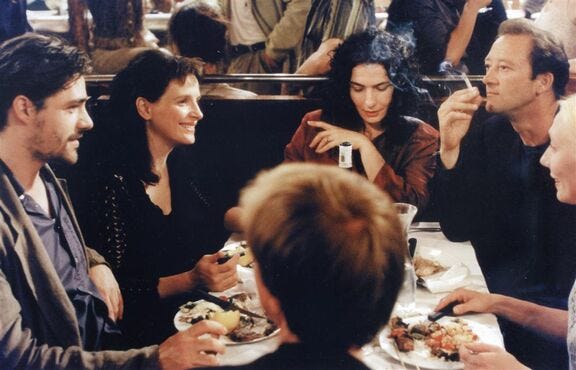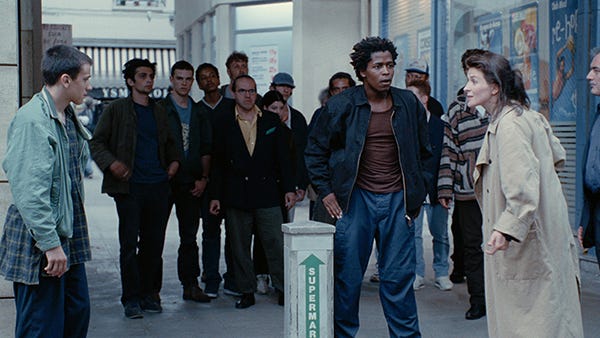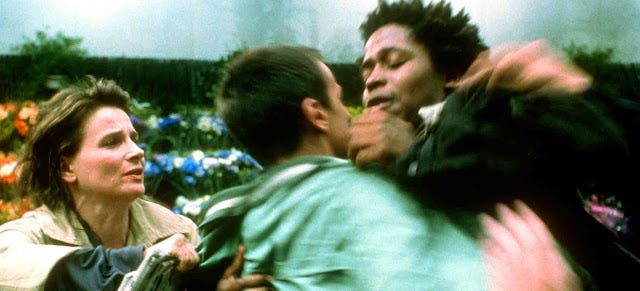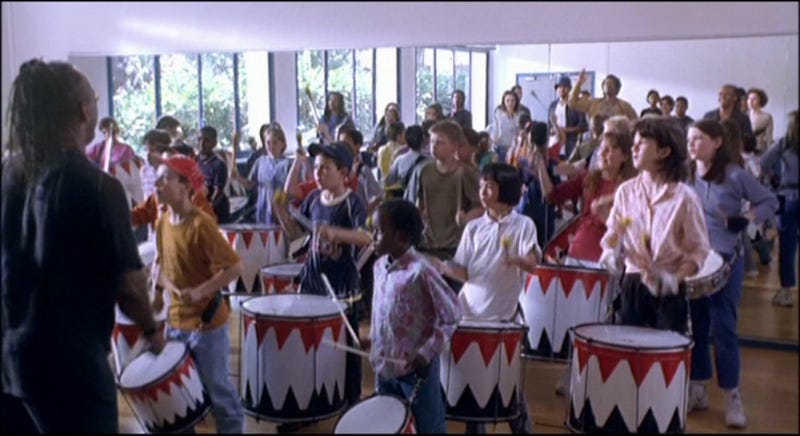"It is the duty of art to ask questions, not provide answers." – Michael Haneke
Hi, everyone!
Before moving on to the rest of material about Michael Haneke’s Code Unknown, please listen to the 10-minute recording above. I am still newish to some features of Substack software, so I have no idea how to move the recording down into the body of the letter lol.
I hope that you can join us for the film discussion about Code Unknown (which can be viewed on Prime, Youtube, Apple, etc.) this SATURDAY, May 18, at 2 pm ET (7 pm UK time/ 8 pm EU time). HERE IS THE ZOOM LINK.
Following on from the intro to the film recorded above, here are the names of the film’s main characters:
Anne, an actress
Georges, her boyfriend who is a photojournalist in war zones
Georges’ younger brother, Jean
Georges’ farmer father
Maria, a Romanian woman who is begging on the streets of Paris
Amadou, a West African immigrant, and his family
During our last eight film discussions, we have focused a lot on the nature of perception. The films of Austrian filmmaker Michael Haneke–often disorienting and shocking–take these questions to a different level. An introductory post about Haneke’s 2007 retrospective at the Museum of Modern Art in New York focuses on the reasons behind the shock, arguing that Haneke’s narratives are “told with exquisite precision and in riveting detail, that shock viewers out of their willful indifference to the suffering of others and challenge their unquestioning acceptance of mediated reality.”
As a filmmaker, Haneke’s prime means of communication is “mediated reality,” and Code Unknown, in particular, interrogates this. In an interview about Code Unknown, Haneke explains that “A film is not reality. It is a model of reality, if you like. Reality is too complex to capture.” He continues by making the point that it is even more difficult to make a documentary than a fiction film, in this regard, because a documentary shows only a tiny part of real “reality” yet claims to represent reality itself.
Along these lines, perhaps nonfiction is less true than fiction because fiction does not claim to be “real.” The oft quoted Picasso line gets close–but perhaps not close enough–to the truth of the matter here: “Art is a lie that makes us realize truth, at least the truth that is given us to understand.” Yes, art is a “lie” when it pretends to hold up a mirror reflecting reality. After the modernist “crisis of representation” following World War I, many artists were challenging the notion that linear narratives, “realistic” portraits, and the like were honest depictions of “reality.” In fact, these conventional art forms were the most dishonest, claiming mimesis (direct imitation) when there is no way to recreate any sort of objective reality in art.
In Haneke’s cinematic worlds, the central “truth” is that reality is based on questions rather than seamless, full resolutions. There is a continual disconnect between art and reality, between ideas and their manifestation, and, ultimately, between one human being’s effort to communicate with another. The codes of fulfilled meaning are unknown. As viewers of Haneke’s film, we also misinterpret the codes that we are given. As Justin Morrow notes, “By confronting viewers with the shock of having a persistent illusion shattered, Haneke's methods are meant not only to tell stories, but to challenge the very notion of what the effects of artifice are on human perception.” Although we watch characters on the screen act in problematic ways based on false assumptions or misinterpretations, we are also misinterpreting codes that are being relayed to us. You can see this especially in multiple acting scenes that feature Anne. Were you initially fooled when watching these?
Haneke admits that art manipulates us into trusting a particular narrative version of really. And in his films, he wants to make viewers aware of this manipulation, a philosophical turn that manifests itself into a filmmaking style. This, Haneke claims, is his being “more honest” with his viewers. In many ways, Haneke’s film techniques are comparable to some used by authors writing within the postmodern literary genre called metafiction. While Haneke does not insert himself directly into the narrative (as do some metafictional authors), his style of filmmakinging is perpetually reminding us that what we are seeing is being controlled and manipulated by an artist on the other side of the camera. At times, Code Unknown feels like a melodrama, at times it feels like a documentary or Cinéma vérité. But it deconstructs these categories of art more than it stays within drawn lines of each genre. Haneke very much resists the smooth, entertaining storytelling of mainstream cinema because “mainstream cinema lives off of the pious lie that they [the big problems of life] can be solved.” Is Haneke’s filmmaking style truly more honest? And is this something that will ever be accepted by large audiences?
As T.S. Eliot once told us, “Humankind cannot bear very much reality.”
Interestingly, the characters Anne and Georges are both artists on different sides of a camera. As an actress, Anne is subject to gaze of camera, director and–finally–the audience. There are times when she appears vulnerable, endangered, confused. How much do these “fake” acting scenes impact the way we interpret her character? Georges is a photographer, so he is the one behind/ manipulating a camera. At one point of the film, we see a sequence of black and white photos overlaid with a voiceover of Georges reading a letter he sent to Anne.
The voiceover describes his own captivity in Afghanistan and his own remembrances of misinterpreting a code: “What can I do for you?.” As we see these images and listen to Georges’ account, it is important to note that he has taken these photos on the metros without the consent of the subjects. He has covertly “captured” their likenesses for the sake of his art. Haneke only reveals this to us later in the film.
It is also fascinating to consider the dinner conversation between Georges and his cynical friend, Francine, in the middle of Code Unknown. Georges has only recently returned from Kosovo, where he has taken gruesome, hyper-realist photos of death and destruction.
Francine: “You think you have to photograph death and destruction to know what war is? And those Indian kids so I know what famine is. What a dumb assumption!”
George: “We are talking about different things, Francine. For you, it is theory. For me, it is real life.”
Francine: “But you can’t convey that in your pictures.
In Georges’ voiceover narrative about his captivity, he admits that Francine might be right. Is Francine channeling Haneke’s voice?
As you will have noted, I have not mentioned much in this newsletter about the very prominent themes of race and class at the core of the film. This is because I want to wait for our Saturday discussion with Drs. Tagayuna and Wienk. For this newsletter, I am providing you with some ideas/ information about Haneke’s filmmaking in general and encouraging you to think about how he deconstructs the use of visual media as a means to capture and retell narratives that may or may not “reflect reality.” Of course, all of this directly relates to societal constructs of class, race, and understandings of disability. These provide the major points of misunderstanding, disconnect, and violence in the film. I look forward to diving into that conversation on Saturday!
“Although the film is an artfully fragmented work, consisting of forty-two discrete scenes, divided by cuts to black, that constantly try to pull the rug out from under our expectations, the tension between Northern European citizens and immigrant populations is its overriding theme.”–Nick James, editor of Sight & Sound writing for The Criterion Collection
HERE ARE A FEW SPECIFIC QUESTIONS TO CONSIDER:
Why does the film open and close with scenes in a classroom for deaf children?
Note the parallels and differences between Jean’s attack on Maria at the beginning of the film and the Algerian teenager’s attack of Anne near the end of the film. These two scenes frame the film’s main content.
Consider the significance of Amadou’s role teaching drumming to deaf children. Also consider how the persistent drumbeat is used in the next to last scene. Is it ominous or unifying?
Why does Maria return to France and to the same area from which she was formerly deported?
Analyze the communication between Georges and Anne, especially the grocery store scene.
How does the death of the child in Anne’s apartment building relate to the film’s themes.
As per the questions (related to TS Eliot’s Waste Land) in my recording, think through whether this film is full of despair or provides any hope for decoding symbols and achieving community.
How do the tensions of race and class that are so prevalent in the film relate to the larger questions about art as mimesis (whether art can truly “imitate reality”?
Thanks for reading, all! I hope to see you this Saturday to discuss this fascinating film!
p.s. Here is a FINAL WORD from Haneke about final words!

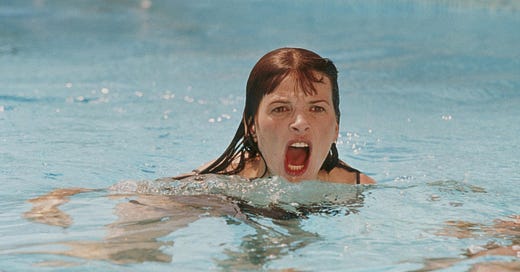



![Code Unknown – [FILMGRAB] Code Unknown – [FILMGRAB]](https://substackcdn.com/image/fetch/$s_!02uQ!,w_1456,c_limit,f_auto,q_auto:good,fl_progressive:steep/https%3A%2F%2Fsubstack-post-media.s3.amazonaws.com%2Fpublic%2Fimages%2F20fe1c5d-0a4b-4c00-82e2-39f6257b5594_500x279.jpeg)


